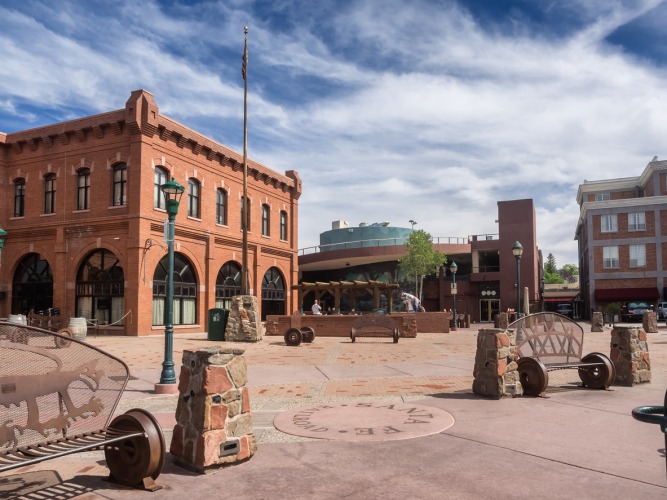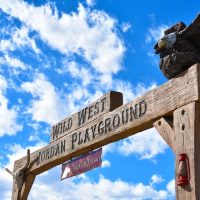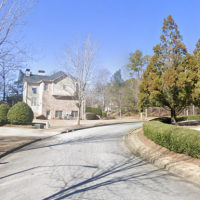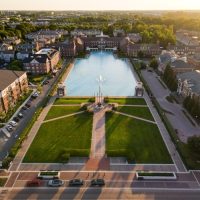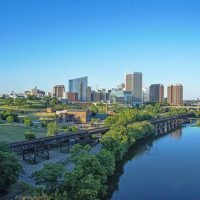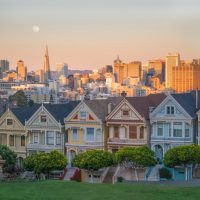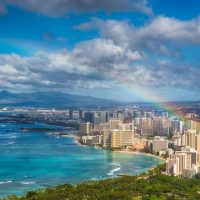If you are considering living in Flagstaff, Arizona, you will want to understand the pros and cons of living there.
Flagstaff has a lot to offer, but it also has its downsides.
Whether Flagstaff is a good place to live will depend on what is important to you.
Let’s take a look at the pros and cons of living in Flagstaff, AZ.
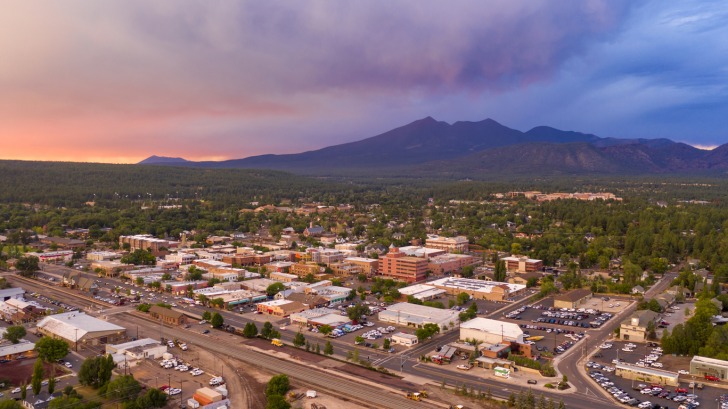
Contents
Pros of Living in Flagstaff
There are many pros of living in Flagstaff, AZ.
These benefits include:
- Cultural Activities
- Urban Trail System
- Nature Areas Surround the City
- Cooler Temperatures (for Arizona)
- Eclectic Food Scene
- Grand Circle Parks and Monuments
- Dark Sky City
- Healthy and Sustainable Living
- Friendly Residents
1. Cultural Activities
If you enjoy an active cultural scene, you’ll love Flagstaff.
It’s a relatively small city, so you may be surprised by what it has to offer.
One reason for this is because it’s a college town, with the Northern Arizona University located here.
You’ll find festivals, plays, museums, and art galleries to enjoy.
The Orpheum Theatre is a local favorite.
2. Urban Trail System
If you want to be active and enjoy nature without going out of your way, you’ll enjoy the urban trail system in Flagstaff.
There are currently more than 50 miles of trails within the city limits.
A 42-mile trail loop is under construction, to provide even more nature opportunities.
You can walk, ride, or jog these trails.
Some trails are suitable for strollers or taking your pooch for a walk.
3. Nature Areas Surround the City
If you want more nature, Flagstaff is the city for you.
It’s surrounded by the world’s largest Ponderosa Pine Forest.
These trees are a beautiful reddish brown and smell like vanilla.
You’ll also find mountains, including Humphrey’s Peak.
At 12,000 feet, it’s the highest point in the city.
You can even go caving in the extensive lava river caves, and fish or swim at Lake Mary.
4. Cooler Temperatures
Flagstaff has relatively moderate temperatures for the Southwest and allows you to experience all 4 seasons.
Flagstaff’s elevation means that you’ll get plenty of snow in the wintertime.
In the summer, temps do rise, but the area is cooler than other parts of Arizona and surrounding states.
In fact, temperatures are usually in the 80s in the summer, and about 20 degrees cooler than other areas of the state.
Low humidity and cool evenings make even the hottest days bearable.
In the fall, the temperatures cool and the leaves change colors, making for perfect fall weather.
5. Eclectic Food Scene
Flagstaff has an exciting and eclectic food scene as well as a thriving cultural scene.
In fact, it’s considered a popular foodie destination.
You’ll find nearly any type of food, including Mexican, Greek, Chinese, and even Himalayan cuisine.
There are plenty of frozen yogurt and ice cream shops, as well as chain restaurants like Olive Garden and Red Lobster, so there’s something for everyone.
6. Grand Circle Parks and Monuments
The Grand Circle is a part of the Southwest that has an extremely high concentration of national monuments and parks.
In fact, you will be less than 1 1/2 hours from the Grand Canyon.
You can also reach natural attractions including Lake Powell, Walnut Canyon, Sunset Crater Volcano, and the Petrified Forest quickly.
If you are willing to travel a little farther, you can visit Colorado‘s Black Canyon or Canyon Lands in Utah.
When you live in Flagstaff an America the Beautiful Park pass is a great investment.
This allows you to visit national parks without paying an entrance fee for one year.
7. Dark Sky City
When you live in a city, you typically give up views of the stars at night due to light pollution.
Flagstaff is the first official dark sky city in the world.
The city got the title in 2001.
Flagstaff is dedicated to reducing light pollution as much as possible.
You can actually look up and enjoy the stars, which are stunning in the city.
In fact, there are rules that houses and businesses must follow to prevent light pollution.
Flagstaff also has the Lowell Observatory.
The observatory actually discovered Pluto and offers an up-close look at our skies.
8. Healthy and Sustainable Living
Flagstaff residents also enjoy healthy and sustainable living.
You’ll find plenty of organic produce, health food and natural supplement stores, and farmer’s markets.
You’ll also find sustainability programs, including recycling, and solar energy.
Flagstaff even has a Bike to Work Week, which encourages residents to take their bikes rather than their cars to work.
This has benefits for the health of the person, city, and the planet.
9. Friendly Residents
Flagstaff is known as a friendly city.
In this way, it has a small-town feel.
You’ll find a mix of young, adult, and senior residents.
Because it’s a college town, you can expect some people to come and go.
However, there are plenty of residents who plan to spend their lives in the city.
Cons of Living in Flagstaff, AZ
Before you begin packing your bags, you should take a look at the cons of living in Flagstaff as well.
The downsides of living in Flagstaff include:
- Thinner Air
- Expensive Housing Costs
- High Cost of Living
- Limited Job Opportunities
- Extreme Weather
- Dangerous Animals
- Traffic Congestion
- Can Feel Isolated
1. Thinner Air
If you are used to lower elevations, living in Flagstaff will take some getting used to.
The air is significantly thinner in the city because it’s at 7,000 feet above sea level.
You may find working out challenging.
In fact, even daily activities can take your breath away.
The good news is that over time, your body will get used to this.
Some diseases, like obesity and diabetes, are less common at higher elevations.
On the other hand, lung problems like COPD are more prevalent.
2. Expensive Housing Costs
One of the bigger downsides to living in Flagstaff is the cost of housing.
In fact, the cost of purchasing a house in the city is 60% higher than the national average, which is stunning.
The median home price in Flagstaff is $775,000.
3. High Cost of Living
In addition to expensive housing, the cost of living in Flagstaff is also more expensive than average.
The cost of living in the city is 14% above the national average, which can make it difficult to get by, particularly if you are not financially secure.
4. Limited Job Opportunities
Along with high costs, job opportunities in Flagstaff are limited.
The tourism and hospitality industries are popular, but other professions are few and far between.
Government and healthcare jobs are also common, and there are a few major manufacturers in the area.
5. Extreme Weather
Flagstaff has four seasons, but the weather can be unpredictable and extreme at times.
In the summer, dry conditions and hot temperatures bring the risk of wildfires.
During monsoon season, the city gets heavy rains.
This can lead to flooding.
Floods are more likely in areas that have recently had wildfires because these areas lose their vegetation.
During the winter, you can expect to get snow.
If you enjoy the white stuff, this is a perk.
However, temperatures below zero and heavy snows or blizzards are not ideal.
6. Dangerous Animals
This is an issue in many cities in the U.S., and around the world, but it bears mentioning.
Black bears, skunks, and Gila monsters are a few dangerous critters that share Flagstaff with its human residents.
You may also meet some venomous animals, including scorpions, black widows, and Africanized bees.
Of course, the biggest danger in the area is rattlesnakes.
Flagstaff is home to Western Diamondback, Mojave, and Black-tailed rattlesnakes.
A bite from one of these serpents can be deadly without medical care.
The good news is that medical professionals have the skills and anti-venom to treat bites.
Rattlesnakes aren’t typically aggressive, and they generally want to be left alone.
They will attack in self-defense, but they will not seek out a confrontation on purpose.
7. Traffic Congestion
Flagstaff is a small to midsize city, with big city traffic issues.
Tourism is popular year-round, and it’s also a college town.
These factors contribute to traffic congestion.
You may find it difficult to get around in the city, particularly during busier times of the day.
8. Can Feel Isolated
Flagstaff feels like a city in the middle of nowhere, and essentially, it is.
The nearest big city is Phoenix, which is a 2-hour drive from Flagstaff.
If you want to find things that aren’t offered locally, you’ll need to be prepared to travel to get them.
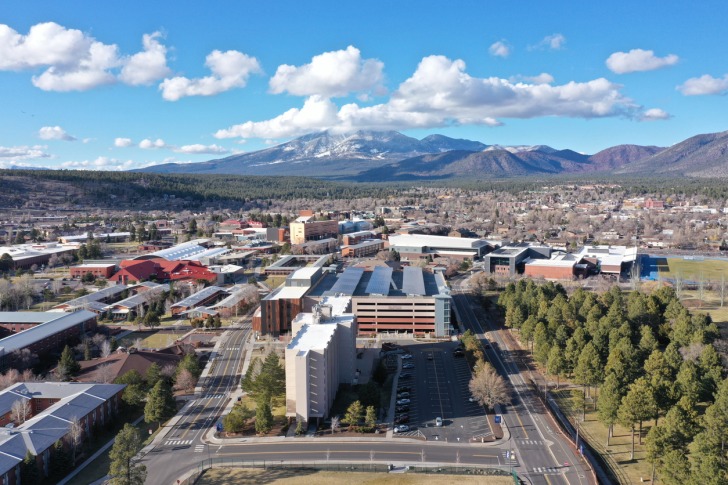
Pros and Cons of Living in Flagstaff, AZ – Summary Table
| Pros of Living in Flagstaff | Cons of Living in Flagstaff, AZ |
|---|---|
| 1. Cultural Activities | 1. Thinner Air |
| 2. Urban Trail System | 2. Expensive Housing Costs |
| 3. Nature Areas Surround the City | 3. High Cost of Living |
| 4. Cooler Temperatures | 4. Limited Job Opportunities |
| 5. Eclectic Food Scene | 5. Extreme Weather |
| 6. Grand Circle Parks and Monuments | 6. Dangerous Animals |
| 7. Dark Sky City | 7. Traffic Congestion |
| 8. Healthy and Sustainable Living | 8. Can Feel Isolated |
| 9. Friendly Residents |
Flagstaff Safety Overview
READ THE FULL REPORT: Flagstaff Safety Review
Safety Index: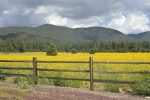
- OVERALL RISK: LOW
- TRANSPORT & TAXIS RISK: LOW
- PICKPOCKETS RISK: LOW
- NATURAL DISASTERS RISK: MEDIUM
- MUGGING RISK: LOW
- TERRORISM RISK: LOW
- SCAMS RISK: LOW
- WOMEN TRAVELERS RISK: MEDIUM
Frequently Asked Questions
Is Flagstaff Arizona a good place to live?
Flagstaff is a good place to live if the things it has to offer are important to you.
This includes natural beauty, a thriving cultural scene, and healthy living.
However, you’ll also deal with high housing and living costs and limited job opportunities.
Is Flagstaff a good place to retire?
Flagstaff is a good place to retire if you can afford the cost of living.
The city has the most high-quality hospitals that accept Medicare in a 50-mile radius per 100,000 residents.
There’s also lots to do, including outdoor activities, museums, and plays.
The moderate summer temperatures can also make it an attractive place for retirees.
What income do you need to live in Flagstaff?
Due to the high cost of living, you’ll need a steady income if you plan to move to Flagstaff.
One person will need to earn at least $40,000 before taxes to survive in the city.
A family of two adults and one child will need an income of nearly $80,000 to earn a living wage.
Does Flagstaff get a lot of snow?
Yes, Flagstaff gets a lot of snow each year.
The average snowfall is over 100 inches in the city.
This makes Flagstaff a great place to enjoy a white Christmas or winter sports, like skiing or snowboarding.
What makes Flagstaff special?
Flagstaff is special due to its geographical location and natural surroundings.
The pine forest and mountains make the area unique.
Friendly residents and a thriving city with a small-town feel are also reasons to love this city.
